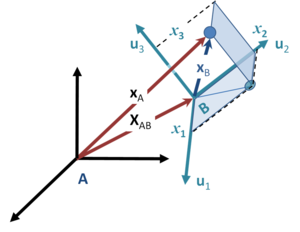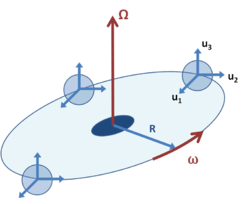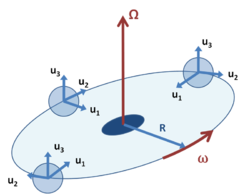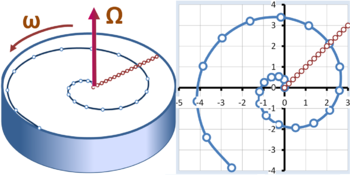Inertial forces
Inertial forces are forces introduced to enable the use of laws of motion (whether Newton's laws or those of special relativity) in accelerating frames of reference, such as rotating frames.
The laws of motion are set up for use in an inertial frame, a frame often thought of as moving in a straight line at constant speed relative to the "fixed stars", a shorthand for identifying the universe as a whole. However, most observations actually occur in accelerating frames, for example, rotating frames. An example is the Earth, which participates in its own rotation (an acceleration), orbiting the Sun (another acceleration) and following the Sun in its travels with the Milky Way. Other examples are satellites[1][2] and particle accelerators.[3] Consequently, it is useful to describe how the laws of motion can be applied in such noninertial frames. This application involves the introduction of inertial forces that behave like real forces in an accelerating frame, but to the inertial observer appear as artifacts of the acceleration of the noninertial frame. For this reason, these forces are viewed as somewhat artificial (they do not originate in physical bodies like masses, charges or nuclei), and so are referred to often as fictitious forces. It must be born in mind, however, that the designation "fictitious" is used only in a technical sense as a reminder that in an inertial frame these forces are not necessary to the analysis. These forces are not at all fictitious as in ordinary English usage, referring to the imaginary or fictional, and in the accelerating frame inertial forces are just as real as the forces recognized in an inertial frame, and have real consequences just like other forces.
This article treats inertial forces from the viewpoint of Newton's laws of motion, and is non-relativistic.

An object located at xA in inertial frame A is located at location xB in accelerating frame B. The origin of frame B is located at XAB in frame A. The orientation of frame B is determined by the unit vectors along its coordinate directions, uj with j = 1, 2, 3. Using these axes, the coordinates of the object according to frame B are xB = (x1, x2, x3).
General derivation
The figure shows a particle with mass m and position vector xA(t) in a particular inertial frame A. Consider a non-inertial frame B whose origin relative to the inertial one is given by XAB(t). Let the position of the particle in frame B be xB(t). What is the force on the particle as expressed in the coordinate system of frame B? [4][5]
To answer this question, let the coordinate axis in B be represented by unit vectors uj with j any of { 1, 2, 3 } for the three coordinate axes. Then
The interpretation of this equation is that xB is the vector displacement of the particle as expressed in terms of the coordinates in frame B at time t. From frame A the particle is located at:
As an aside, the unit vectors { uj } cannot change magnitude, so derivatives of these vectors express only rotation of the coordinate system B. On the other hand, vector XAB simply locates the origin of frame B relative to frame A, and so cannot include rotation of frame B.
Taking a time derivative, the velocity of the particle is:
The second term summation is the velocity of the particle, say vB as measured in frame B. That is:
The interpretation of this equation is that the velocity of the particle seen by observers in frame A consists of what observers in frame B call the velocity, namely vB, plus two extra terms related to the rate of change of the frame-B coordinate axes. One of these is simply the velocity of the moving origin vAB. The other is a contribution to velocity due to the fact that different locations in the non-inertial frame have different apparent velocities due to rotation of the frame; a point seen from a rotating frame has a rotational component of velocity that is greater the further the point is from the origin.
To find the acceleration, another time differentiation provides:
Using the same formula already used for the time derivative of xB, the velocity derivative on the right is:
Consequently,
The interpretation of this equation is as follows: the acceleration of the particle in frame A consists of what observers in frame B call the particle acceleration aB, but in addition there are three acceleration terms related to the movement of the frame-B coordinate axes: one term related to the acceleration of the origin of frame B, namely aAB, and two terms related to rotation of frame B. Consequently, observers in B will see the particle motion as possessing "extra" acceleration, which they will attribute to "forces" acting on the particle, but which observers in A say are "inertial" forces arising simply because observers in B do not recognize the non-inertial nature of frame B.
The factor of two before one of the summations arises from two equal contributions: (i) the apparent change of an inertially constant velocity with time because rotation makes the direction of the velocity seem to change (a dvB / dt term) and (ii) an apparent change in the velocity of an object when its position changes, putting it nearer to or further from the axis of rotation (the change in Σxj duj/dt due to change in all the { x j }).
To put matters in terms of forces, the accelerations are multiplied by the particle mass:
The force observed in frame B, FB = m aB is related to the actual force on the particle, FA, by:
where the inertial forces are:
Thus, we can solve problems in frame B by assuming that Newton's second law holds (with respect to quantities in that frame) and treating Fintl as an additional force.[6][7][8]
Below are a number of examples applying this result for inertial forces. More examples can be found in the article on centrifugal force.
Rotating coordinate systems
A common situation in which noninertial reference frames are useful is when the reference frame is rotating. Because such rotational motion is non-inertial, due to the acceleration present in any rotational motion, a inertial force can always be invoked by using a rotational frame of reference. Despite this complication, the use of inertial forces often simplifies the calculations involved.
To derive expressions for the inertial forces, derivatives are needed for the apparent time rate of change of vectors that take into account time-variation of the coordinate axes. If the rotation of frame B is represented by a vector Ω pointed along the axis of rotation with orientation given by the right-hand rule, and with magnitude given by
then the time derivative of any of the three unit vectors describing frame B is:[7][9]
and
as is verified using the properties of the vector cross product. These derivative formulas now are applied to the relationship between acceleration in an inertial frame, and that in a coordinate frame rotating with time-varying angular velocity ω ( t ). From the previous section, where subscript A refers to the inertial frame and B to the rotating frame, setting aAB = 0 to remove any translational acceleration, and focusing on only rotational properties (see Eq. 1):
Collecting terms, the result is the so-called acceleration transformation formula:[10]
The physical acceleration aA due to what observers in the inertial frame A call real external forces on the object is, therefore, not simply the acceleration aB seen by observers in the rotational frame B , but has several additional geometric acceleration terms associated with the rotation of B. As seen in the rotational frame, the acceleration aB of the particle is given by rearrangement of the above equation as:
The net force upon the object according to observers in the rotating frame is FB = m aB. If their observations are to result in the correct force on the object when using Newton's laws, they must consider that the additional force Fintl is present, so the end result is FB = FA + Fintl. Thus, the inertial force used by observers in B to get the correct behavior of the object from Newton's laws equals:
Here, the first term is the Coriolis force,[11] the second term is the centrifugal force,[12] and the third term is the Euler force.[13][14] When the rate of rotation doesn't change, as is typically the case for a planet, the Euler force is zero.
Orbiting coordinate systems

An orbiting but fixed orientation coordinate system B, shown at three different times. The unit vectors uj, j = 1, 2, 3 do not rotate, but maintain a fixed orientation, while the origin of the coordinate system B moves at constant angular rate ω about the fixed axis Ω. Axis Ω passes through the origin of inertial frame A, so the origin of frame B is a fixed distance R from the origin of inertial frame A.
As a related example, suppose the moving coordinate system B rotates in a circle of radius R about the fixed origin of inertial frame A, but maintains its coordinate axes fixed in orientation, as in the figure. The acceleration of an observed body is now (see Eq. 1):
where the summations are zero inasmuch as the unit vectors have no time dependence. The origin of system B is located according to frame A at:
leading to a velocity of the origin of frame B as:
leading to an acceleration of the origin of B given by:
Because the first term, which is
is of the same form as the normal centrifugal force expression:
it is a natural extension of standard terminology (although there is no standard terminology for this case) to call this term a "centrifugal force". Whatever terminology is adopted, the observers in frame B must introduce a inertial force, this time due to the acceleration from the orbital motion of their entire coordinate frame, that is radially outward away from the center of rotation of the origin of their coordinate system:
and of magnitude:
Notice that this "centrifugal force" has differences from the case of a rotating frame. In the rotating frame the centrifugal force is related to the distance of the object from the origin of frame B, while in the case of an orbiting frame, the centrifugal force is independent of the distance of the object from the origin of frame B, but instead depends upon the distance of the origin of frame B from its center of rotation, resulting in the same centrifugal inertial force for all objects observed in frame B.
Orbiting and rotating
As a combination example, the figure shows a coordinate system B that orbits inertial frame A as in the previous firgure, but the coordinate axes in frame B turn so unit vector u1 always points toward the center of rotation. This example might apply to a test tube in a centrifuge, where vector u1 points along the axis of the tube toward its opening at its top. It also resembles the Earth-Moon system, where the Moon always presents the same face to the Earth.[15] In this example, unit vector u3 retains a fixed orientation, while vectors u1, u2 rotate at the same rate as the origin of coordinates. That is,
Hence, the acceleration of a moving object is expressed as (see Eq. 1):
where the angular acceleration term is zero for constant rate of rotation. Because the first term, which is
is of the same form as the normal centrifugal force expression:
it is a natural extension of standard terminology (although there is no standard terminology for this case) to call this term the "centrifugal force". Applying this terminology to the example of a tube in a centrifuge, if the tube is far enough from the center of rotation, |XAB| = R >> |xB|, all the matter in the test tube sees the same acceleration (the same centrifugal force). Thus, in this case, the inertial force is primarily a uniform centrifugal force along the axis of the tube, away from the center of rotation, with a value |FCfgl| = ω2 R, where R is the distance of the matter in the tube from the center of the centrifuge. It is standard specification of a centrifuge to use the "effective" radius of the centrifuge to estimate its ability to provided centrifugal force. Thus, a first estimate of centrifugal force in a centrifuge can be based upon the distance of the tubes from the center of rotation, and corrections applied if needed.[16][17]
Also, the test tube confines motion to the direction down the length of the tube, so vB is opposite to u1 and the Coriolis force is opposite to u2, that is, against the wall of the tube. If the tube is spun for a long enough time, the velocity vB drops to zero as the matter comes to an equilibrium distribution. For more details, see the articles on sedimentation and the Lamm equation.
A related problem is that of centrifugal forces for the Earth-Moon-Sun system, where three rotations appear: the daily rotation of the Earth about its axis, the lunar-month rotation of the Earth-Moon system about their center of mass, and the annual revolution of the Earth-Moon system about the Sun. These three motions influence the tides.[18]
Crossing a carousel
See also the discussion at Carousel.
The figure shows another example comparing the observations of an inertial observer with those of an observer on a rotating carousel.[19] The carousel rotates at a constant angular velocity represented by the vector Ω with magnitude ω, pointing upward according to the right-hand rule. A rider on the carousel walks radially across it at constant speed, in what appears to the rotating observer to be the straight line path inclined at 45° in the figure . To the stationary observer, however, the walker travels a spiral path. The points identified on both paths in the figure correspond to the same times spaced at equal time intervals. We ask how two observers, one on the carousel and one in an inertial frame, formulate what they see using Newton's laws.
Inertial observer
The observer at rest describes the path followed by the walker as a spiral. Adopting the coordinate system shown in the figure, the trajectory is described by r ( t ):
where the added π/4 sets the path angle at 45° to start with (just an arbitrary choice of direction), uR is a unit vector in the radial direction pointing from the center of the carousel to the walker at time t. The radial distance R(t) increases steadily with time according to:
with s the speed of walking. According to simple kinematics, the velocity is then the first derivative of the trajectory:
with uθ a unit vector perpendicular to uR at time t (as can be verified by noticing that the vector dot product with the radial vector is zero) and pointing in the direction of travel. The acceleration is the first derivative of the velocity:
The last term in the acceleration is radially inward of magnitude ω2 R, which is therefore the instantaneous centripetal acceleration of circular motion.[20] The first term is perpendicular to the radial direction, and pointing in the direction of travel. Its magnitude is 2sω, and it represents the acceleration of the walker as the edge of the carousel is neared, and the arc of circle traveled in a fixed time increases, as can be seen by the increased spacing between points for equal time steps on the spiral in the figure as the outer edge of the carousel is approached.
Applying Newton's laws, multiplying the acceleration by the mass of the walker, the inertial observer concludes that the walker is subject to two forces: the inward, radially directed centripetal force, and another force perpendicular to the radial direction that is proportional to the speed of the walker.
Rotating observer
The rotating observer sees the walker travel a straight line from the center of the carousel to the periphery, as shown in the figure. Moreover, the rotating observer sees that the walker moves at a constant speed in the same direction, so applying Newton's law of inertia, there is zero net force upon the walker. These conclusions do not agree with the inertial observer, who sees a curved path. Agreement with the inertial observer so far as the forces exerted upon the walker is obtained, however, because the walker has to combat inertial forces in the rotating world in order to travel the straight line. He does not just stroll out to the edge.
The inertial observer views these inertial forces as artifacts of the acceleration of the carousel that have no origin in masses, charges or atomic nuclei, etc. like the forces found in the inertial frame. From the rotating perspective, however, the walker has to struggle against these forces in order to proceed, and although they arise from motion of the frame, they still must be dealt with, as must all the forces in Newton's laws of motion.
The forces applied to the walker are exactly those found above. They can be related to the general formulas already derived, namely:
In this example, the velocity seen in the rotating frame is:
with uR a unit vector in the radial direction. The position of the walker as seen on the carousel is:
and the time derivative of Ω is zero for uniform angular rotation. Noticing that
and
we find:
To obtain a straight-line motion in the rotating world, a force exactly opposite in sign to the inertial force must be applied to reduce the net force on the walker to zero, so Newton's law of inertia will predict a straight line motion, in agreement with what the rotating observer sees. The inertial forces that must be combated are the Coriolis force (first term) and the centrifugal force (second term). (The usage of these terms here is approximate.[21]) By applying forces to counter these two inertial forces, the rotating observer ends up applying exactly the same forces upon the walker that the inertial observer predicted were needed.
Because they differ only by the constant walking velocity, the walker and the rotational observer see the same accelerations. From the walker's perspective, the inertial force is experienced as real, and combating this force is necessary to stay on a straight line radial path holding constant speed. It's like battling a crosswind while being thrown to the edge of the carousel.
Kinematics and kinetics
Notice that this kinematical discussion does not delve into the mechanism that generates the required forces. Their origination is the subject of kinetics. In the case of the carousel, the kinetic discussion might investigate the walker's shoes and the friction they need to generate against the floor of the carousel, or perhaps the dynamics of skateboarding if the walker were replaced by a skateboarder. Whatever the means of travel across the carousel, the forces calculated above using kinematics must be realized so the specified path will be followed. A very rough analogy is heating your house: you must have a certain temperature to be comfortable, but whether you heat by burning gas or by burning coal is another problem. Kinematics sets the thermostat, kinetics fires the furnace.
References
- ↑ Alberto Isidori, Lorenzo Marconi & Andrea Serrani (2003). Robust Autonomous Guidance: An Internal Model Approach. Springer, p. 61. ISBN 1852336951.
- ↑ Shuh-Jing Ying (1997). Advanced Dynamics. Reston VA: American Institute of Aeronautics, and Astronautics, p. 172. ISBN 1563472244.
- ↑ Philip J. Bryant & Kjell Johnsen (1993). The Principles of Circular Accelerators and Storage Rings. Cambridge UK: Cambridge University Press, p. xvii. ISBN 0521355788.
- ↑ Alexander L Fetter & John D Walecka (2003). Theoretical Mechanics of Particles and Continua. Courier Dover Publications, pp. 33–39. ISBN 0486432610.
- ↑ Yung-kuo Lim & Yuan-qi Qiang (2001). Problems and Solutions on Mechanics: Major American Universities Ph.D. Qualifying Questions and Solutions. Singapore: World Scientific, p. 183. ISBN 9810212984.
- ↑ Vladimir Igorevich Arnolʹd (1989). Mathematical Methods of Classical Mechanics. Berlin: Springer, §27 pp. 129 ff.. ISBN 0387968903.
- ↑ Jump up to: 7.0 7.1 John Robert Taylor (2004). Classical Mechanics. Sausalito CA: University Science Books, pp. 343–344. ISBN 189138922X.
- ↑ Kleppner, pages 62-63
- ↑ See for example, JL Synge & BA Griffith (1949). Principles of Mechanics, 2nd Edition. McGraw-Hill, pp. 348–349.
- ↑ R. Douglas Gregory (2006). Classical Mechanics: An Undergraduate Text. Cambridge UK: Cambridge University Press, Eq. (17.16), p. 475. ISBN 0521826780.
- ↑ Georg Joos & Ira M. Freeman (1986). Theoretical Physics. New York: Courier Dover Publications, p. 233. ISBN 0486652270.
- ↑ Percey Franklyn Smith & William Raymond Longley (1910). Theoretical Mechanics. Boston: Gin, p. 118.
- ↑ Cornelius Lanczos (1986). The Variational Principles of Mechanics. New York: Courier Dover Publications, p. 103. ISBN 0486650677.
- ↑ Jerold E. Marsden & Tudor.S. Ratiu (1999). Introduction to Mechanics and Symmetry: A Basic Exposition of Classical Mechanical Systems: Texts in applied mathematics, 17, 2nd Edition. NY: Springer-Verlag, p. 251. ISBN 038798643X.
- ↑ However, the Earth-Moon system rotates about its barycenter, not the Earth's center; see Simon Newcomb (2007). Popular Astronomy. Read Books, p. 307. ISBN 140674574X.
- ↑ Bea K Lalmahomed, Sarah Springman, Bhawani Singh (2002). Constitutive and Centrifuge Modelling: Two Extremes. Taylor and Francis, p. 82. ISBN 9058093611.
- ↑ Raymond Nen (1986). Consolidation of Soils: Testing and Evaluation: a Symposium. ASTM International, p. 590. ISBN 0803104464.
- ↑ D Appleton (1877). The Popular Science Monthly, p. 276.
- ↑ For a similar example, see Ron Schmitt (2002). A Handbook for Wireless/ RF, EMC, and High-Speed Electronics, Part of the EDN Series for Design Engineers. Newnes, pp. 60–61. ISBN 0750674032. , and Douglas C. Giancoli (2007). Physics for Scientists And Engineers With Modern Physics. Pearson Prentice-Hall, p. 301. ISBN 0131495089.
- ↑ Note: There is a subtlety here: the distance R is the instantaneous distance from the rotational axis of the carousel. However, it is not the radius of curvature of the walker's trajectory as seen by the inertial observer, and the unit vector uR is not perpendicular to the path. Thus, the designation "centripetal acceleration" is an approximate use of this term. See, for example, Howard D. Curtis (2005). Orbital Mechanics for Engineering Students. Butterworth-Heinemann, p. 5. ISBN 0750661690. and S. Y. Lee (2004). Accelerator physics, 2nd Edition. Hackensack NJ: World Scientific, p. 37. ISBN 981256182X.
- ↑ A circle about the axis of rotation is not the osculating circle of the walker's trajectory, so "centrifugal" and "Coriolis" are approximate uses for these terms. See note above.




































































